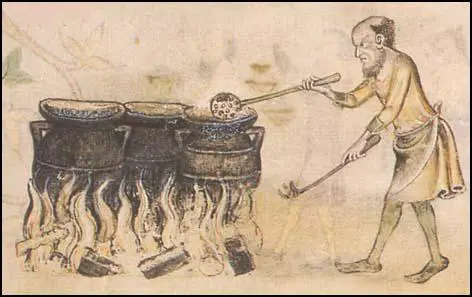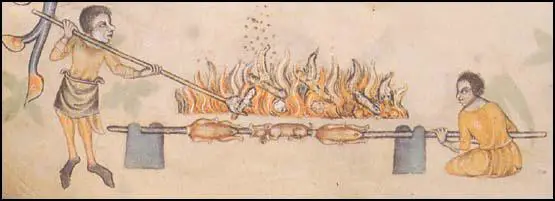Food and Drink in Medieval Britain
The staple food in Yalding is bread. People prefer white bread made from wheat flour. However, only the richer farmers in the village are able to grow the wheat needed to make white bread. Wheat can only be grown in soil that has received generous amounts of manure. Most farmers in Yalding do not have enough animals to produce this manure, so they grow rye and barley instead.
Rye and barley produced a dark, heavy bread. Maslin bread is made from a mixture of wheat and rye flour. After a poor harvest, when grain is in short supply, people are forced to include beans, peas and even acorns in their bread.
Hugh de Audley, like most lords of the manor, does not allow his serfs to bake their bread in their own home. All the serfs in Yalding have to pay to use the lord of the manor's oven.
As well as bread, the people of Yalding also consume a great deal of pottage. This is a kind of soup-stew made from oats. People in Yalding make different types of pottage. Sometimes they add peas and beans. On other occasions they use other vegetables such as onions and parsnips. Leek pottage is especially popular.
The peasants rely mainly on pigs for their regular supply of meat. As pigs are capable of finding their own food in summer and winter, they can be slaughtered throughout the year.

Peasants also eat mutton, but as sheep are small, thin creatures, their meat is not valued very highly. People also use the blood of the slaughtered animal to make black-pudding (blood, milk, animal fat, onions and oats).
There are animals such as deer, wild boar, hares and rabbits living in the woodland surrounding Yalding. These animals are the property of Hugh de Audley and the villagers are not allowed to hunt them. If caught killing these animals, they face the possibility of being punished by having their hands cut off. The people of Yalding do have permission to hunt animals such as hedgehogs and squirrels.
Hugh de Audley has granted permission for people in Yalding to catch dace, grayling and gudgeon from the River Beult. These fish are fairly small and the villagers prefer the large eels that are in the river. They also like the tench, bream and chubb in Hugh de Audley's fish pond. However, if they get caught fishing in the pond they are punished severely at the Manor Court.

Water and milk is drunk by the villagers. The water from the River Beult is unpleasant to drink and milk does not stay fresh for long. The main drink in Yalding is ale. The brewing process takes many days and much labour. The grain, usually barley, has to be soaked for several days, then drained of excess water and carefully germinated to create malt. After the malt is dried and ground, the brewer adds it to hot water for fermentation.
People in Yalding are not allowed to sell ale unless they first gain permission from Hugh de Audley. So far, he has only been willing to grant a licence to produce and sell ale to Edeline Hale and Alice Nash. These women charge 2d. for a gallon of ale.
Questions
(1) Write out five interesting things about food and drink in the 14th century.
2. What was the main drink of the people in Yalding? Why was this drink so popular?
3. Copy this table into your book. Fill it in. The first one has been done for you. You will need to look at the Medieval Recipes sheet before doing this.
Horse Bread
Maslin
bread made from a mixture of wheat and rye flour.
Pottage
Black-Pudding
Lenten Stew
Green Porray
